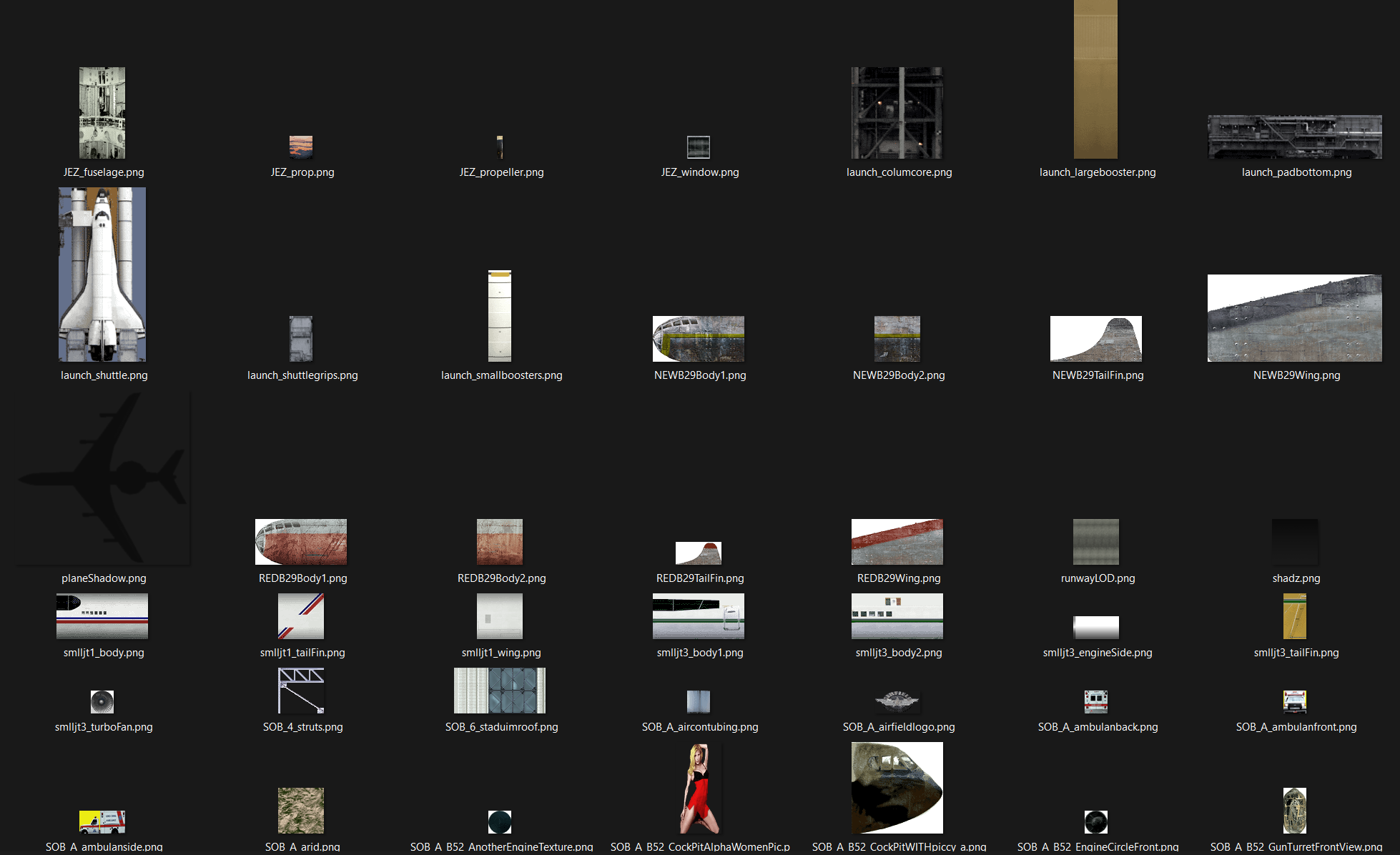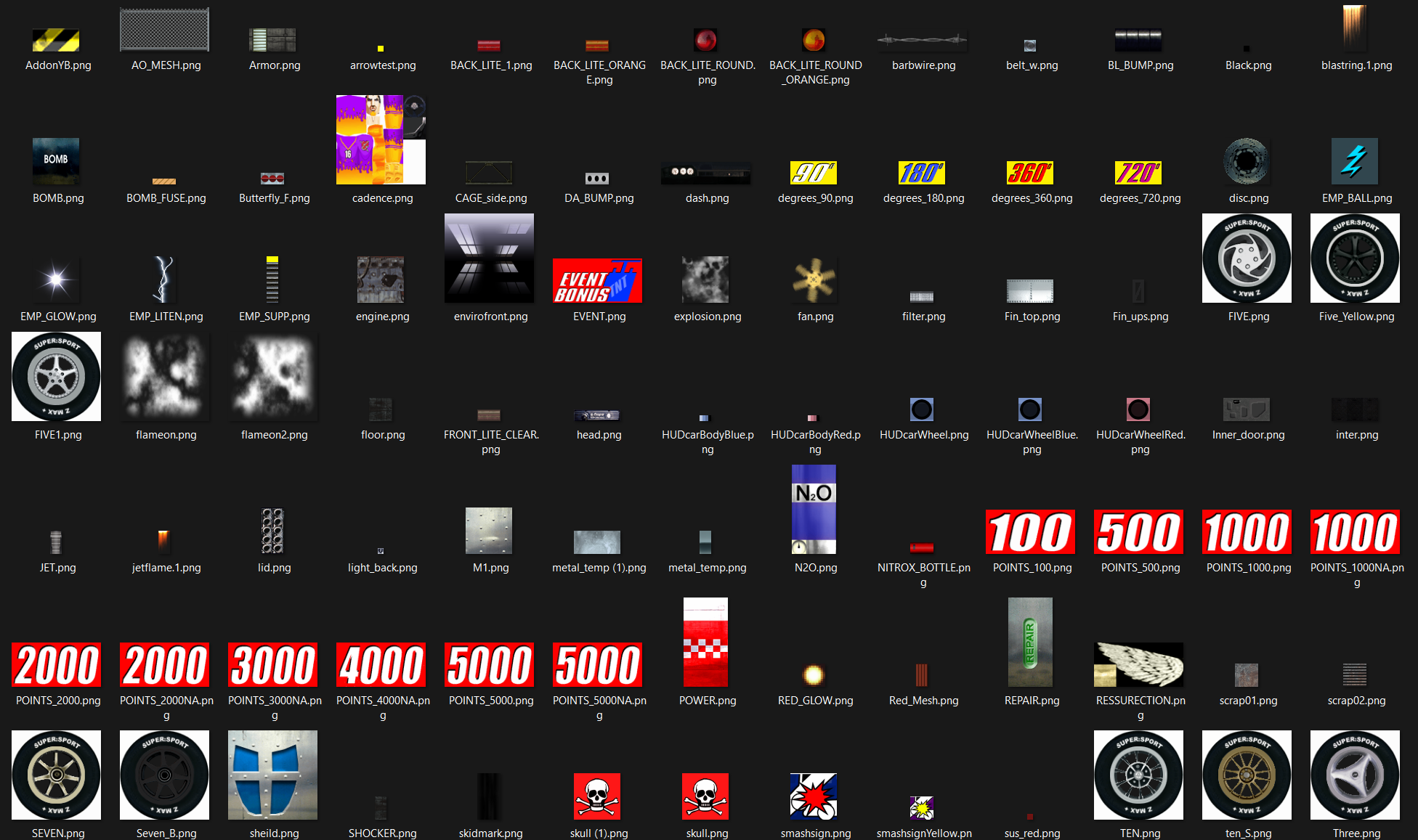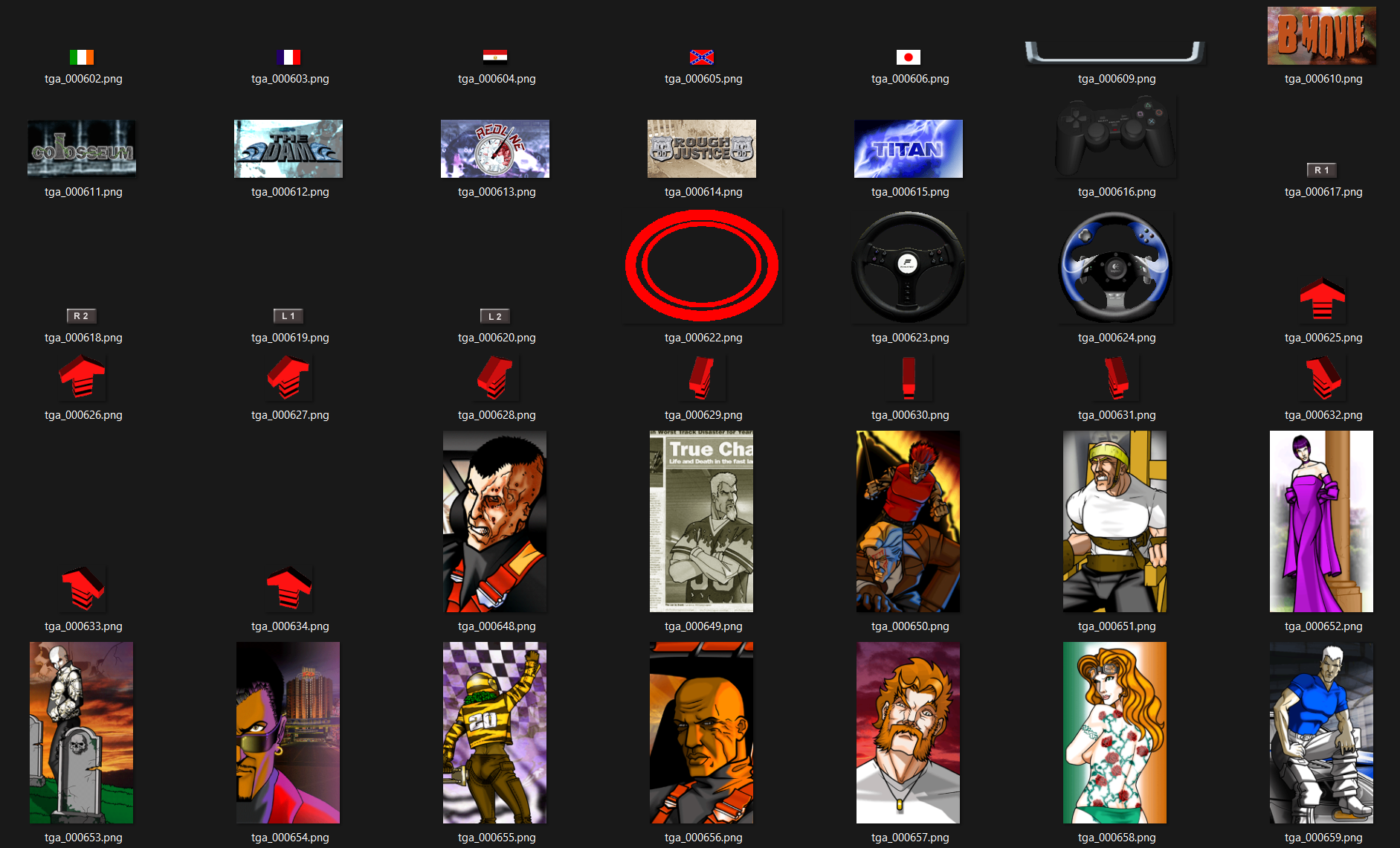Presentation
I'm currently working on a tool (code not published yet since I'm cleaning it before) to extract data from the Destruction Derby Arenas PS2 game made by Studio 33 in 2004.
I'm documenting my researches if other people are interested by data extraction.
Currently I'm able to extract every textures of the game and save them as PNG files and I can extract maps meshes and save them as FBX files (not perfect, still work in progress). I'm not able to extract power ups meshes.
Pictures of some extracted maps:
Contact:
If you want to talk about this project, you can reach me with:
Discord: fewnity
Email: fewnity@gmail.com
LinkedIn: https://www.linkedin.com/in/gregory-machefer-grimaud/
Files Structure
Tracks
Files located in the TRACKS folder.
They contain maps textures, meshes, collisions data, probably navigation meshes and culling informations.
Currently the tool can extract textures and meshes.
Example of extracted textures:

Data
In a map file, the data order will always be the same:
| File header |
|---|
| Mesh table |
| Mesh data |
| Textures |
| Texture table |
File header
| FROM | TO | SIZE | TYPE | DESCRIPTION |
|---|---|---|---|---|
| 0x00 | 0x03 | 4 | UINT32_T | File type |
| 0x04 | 0x07 | 4 | UINT32_T | Ptr to skybox meshes and textures data |
| 0x08 | 0x09 | 4 | UINT32_T | Ptr to texture table headers |
| 0x0C | 0x0F | 4 | STRING | File name |
File type
| VALUE | TYPE |
|---|---|
| 0x20000000 | MAP |
| 0x20010000 | CAR |
| 0x00030000 | FONT |
| 0x00050003 | MENU |
| 0x00050004 | TEXTS |
| 0x04090000 | IN_GAME |
| 0x00050001 | SPRITES |
| 0x000C0001 | CAR_DATA |
Mesh table
There are two lists of data.
In the first list (something like a list of object), each entry has :
An address to a list of pair to map gpu packets with a texture,
A number of pair,
And an address that I don't understand the data it's pointing to.
struct ParentDrawCommandEntry
{
uint32_t vifPacketTexturePairCount;
uint32_t pairListAddress;
uint32_t unkownAddress;
};
The list of pair is composed of a Vif packet list address and an index of texture.
Currently I don't know if there is a way to get the number of vif packet in the list.
Every packets in the list are drawn with the same texture. The texture index references a texture in the texture table.
struct PacketAndTextureEntry
{
uint32_t vifPacketListAddr;
uint32_t textureIndex; // Texture index that is used by the vif packet list
};
Mesh data
A mesh is composed of many vif packets. A vif packet can draw only few triangles.
Every vif packet list starts with a header that like that:
BA 01 00 60 00 00 00 00 00 00 00 00 00 00 00 14
The first two bytes times 16 are the size in byte of the list (without the header). The last byte is unknown.
A vif packet looks like this:

-
Blue parts are VIF UNPACK commands. This command tell the cpu to send data to the gpu memory.
-
The first yellow part is the position and the scale (at the same time) of the triangle batch. (3 floats).
-
The second yellow part is the position but substracted to the other position. (3 floats).
-
Purple parts contains all the vertices positions. 3 uint16_t per vertex.
-
Green parts contains all the vertices UVs. 2 uint16_t per vertex.
-
Red parts contains all the vertices colors. 3 uint8_t per vertex.
-
The first uncolored parts contains the GIF tag. Other uncolored parts are unknown. 3 uint8_t per vertex.
The batch is made of multiple triangles strip. See Triangle Strip on Wikipedia.
A new triangle strip starts when the first bit of the vertex UVs is set to 1.
Textures
In files you can find something like this:
00 00 00 00 80 00 00 00 80 00 00 00 00 00 00 00
2F 2F 55 74 69 6C 69 74 79 2F 65 2F 73 6F 75 72
63 65 49 6D 61 67 65 73 2F 67 6C 61 64 61 74 69
6F 46 69 6E 61 6C 2F 53 4F 42 5F 32 5F 70 69 6C
6C 61 72 62 61 73 65 2E 74 67 61 00 00 00 00 00
the string version of this is:
//Utility/e/sourceImages/gladatioFinal/SOB_2_pillarbase.tga
In the first 16 bytes there are two informations about the texture.
The width in pixel [0x4, 0x7] and the height in pixel [0x8, 0x11].
0xB0 (176) bytes after this block, there is the actual texture data. The data is compressed using a texture palette.
The palette is directly at the end of the texture data.
There is two type of palette, 256 colors (1024 bytes) or 16 colors (64 bytes).
The palette data is "swizzled" and should be "unswizzled". I tried to explain it in a comment:
- 8 first colors are correct --- (For every next 32 colors 8 times) --- The 16 next colors are in the wrong order (need to swap 8 colors first color with the 8 next one) --- Then 16 next colors are correct (only the next 7 times)
- 8 last colors are correct
Once palette data is fixed, the palette can be used to create the final texture.
Skybox texture table
Texture table
At the texture table address you will have the table header, something like that:
01 01 00 05 40 75 00 00 90 84 01 00 47 6C 61 64
20 00 00 00 B8 11 00 00 E0 11 00 00 CC 03 00 00
The 20 00 00 00 value from [0x10, 0x13] is the texture table position offset starting from 0x10.
The B8 11 00 00 value from [0x14, 0x17] is the texture table size in bytes.
Each entry has all the necessary information to extract the texture. There are some unknown values but looks like they are not useful for us.
struct TextureTableEntry
{
uint32_t mipmapCount; // Mipmap count, but weird value if it's an animated texture
ClutType clutType; // Palette type : 19 = 256 colors, 20 = 16 colors
uint32_t width; // Texture width in pixel with the mipmap included
uint32_t height; // Texture height in pixel with the mipmap included
uint32_t unknown0; // Unknown, not an unique value, id in the next table?
uint32_t unknown1; // Always 1
uint32_t texturePosition; // Generally it's a relative position in the file
uint32_t unknown2; // Always 0
uint32_t unknown3; // Unknown, not const (seen values: 16, 32) 32 only seen in winbowl
uint32_t unknown4; // ??? = 16 * clutCount, not true if unknown3 is not egals to 16
uint32_t unknown5; // Always 0
uint32_t clutCount; // Palettes count
uint32_t palettePosition; // Generally it's a relative position in the file
uint32_t textureInfosPosition; // Generally it's a relative position in the file + 0xF to get the file name
// There is the width, height (without the mipmap) and the texture name in the texture infos
};
Cars UBR files
This file contains cars textures and meshes.
Example of extracted textures:

Data
In a map file, the data order will always be the same:
| File header |
|---|
| Mesh table |
| mesh data |
| Textures |
| Texture table |
File header
| FROM | TO | SIZE | TYPE | DESCRIPTION |
|---|---|---|---|---|
| 0x00 | 0x03 | 4 | UINT32_T | File type |
| 0x04 | 0x07 | 4 | UINT32_T | Ptr to texture table headers without the file header padding |
| 0x08 | 0x09 | 4 | UINT32_T | Ptr to texture table headers |
| 0x0C | 0x0F | 4 | STRING | File name |
File type
| VALUE | TYPE |
|---|---|
| 0x20000000 | MAP |
| 0x20010000 | CAR |
| 0x00030000 | FONT |
| 0x00050003 | MENU |
| 0x00050004 | TEXTS |
| 0x04090000 | IN_GAME |
| 0x00050001 | SPRITES |
| 0x000C0001 | CAR_DATA |
Sprites UBR file
This file contains only textures.
It's containing player skins, particules and some UI.
Example of extracted textures:
![]()
Data block header
| FROM | TO | SIZE | TYPE | DESCRIPTION |
|---|---|---|---|---|
| 0x00 | 0x03 | 4 | UINT32_T | File type |
| 0x04 | 0x07 | 4 | UINT32_T | Next texture entry header address |
| 0x08 | 0x09 | 4 | UINT32_T | Size of SPRITES.UBR in bytes |
| 0x0C | 0x0F | 4 | NONE | Empty |
Data
This file does not contain a texture table with every entries following each other. It's one one data block header, then one texture table entry, then one texture header, then the actual texture data and then it's starts again with a data block header.
| File header |
|---|
| Data block header |
| Texture table entry |
| Texture data |
| Data block header |
| Texture table entry |
| ... |
Here is how a texture entry looks like in a file:
(Red part is unknown and black part is not part of the struct).

struct TextureTableEntry
{
uint32_t mipmapCount; // Mipmap count, but weird value if it's an animated texture
ClutType clutType; // Palette type : 19 = 256 colors, 20 = 16 colors
uint32_t width; // Texture width in pixel with the mipmap included
uint32_t height; // Texture height in pixel with the mipmap included
uint32_t unknown0; // Unknown, not an unique value, id in the next table?
uint32_t unknown1; // Always 1
uint32_t texturePosition; // Generally it's a relative position in the file
uint32_t unknown2; // Always 0
uint32_t unknown3; // Unknown, not const (seen values: 16, 32) 32 only seen in winbowl
uint32_t unknown4; // ??? = 16 * clutCount, not true if unknown3 is not egals to 16
uint32_t unknown5; // Always 0
uint32_t clutCount; // Palettes count
uint32_t palettePosition; // Generally it's a relative position in the file
uint32_t textureInfosPosition; // Generally it's a relative position in the file + 0xF to get the file name
// There is the width, height (without the mipmap) and the texture name in the texture infos
};
Here is how a texture hader looks like in a file:

struct TextureHeader
{
uint32_t unkown0;
uint32_t width; // Texture width in pixel without the mipmap
uint32_t height; // Texture height in pixel without the mipmap
uint32_t unkown1;
char filePath[0x80]; // Texture file path, not always present
};
InGame UBR file
This file contains power ups textures and their meshes and some other textures.
Example of extracted textures:

Data
In this file, he data order will be this:
| File header |
|---|
| Textures |
| Mesh table and data multiple time |
| Texture table and unkown data multiple time |
Flash UBR file (menus)
Example of extracted textures:

Data
There is two texture lists, the first one is uncompressed textures and the second one uses a 256 colors palette.
In this file, he data order will be this:
| File header |
|---|
| Unkown data |
| Textures headers |
| Textures data |
| Textures headers |
| Textures data |
| Palette |
Currently the position of the texture header lists are hardcoded in the code, looks like it's a pain to find the address with code. (Address of the Europe version, SCES_507.81)